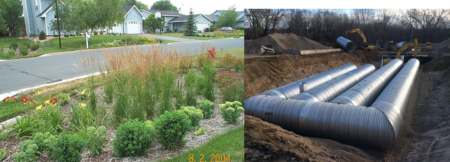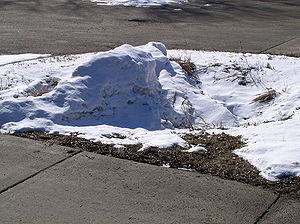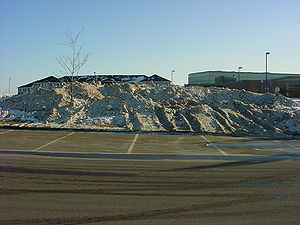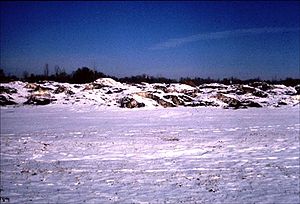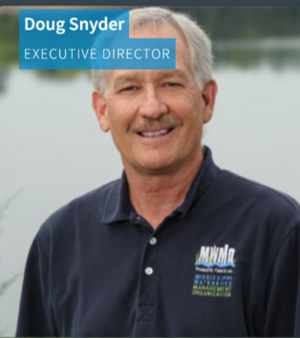
Test page 6 Revision as of 17:40, 2 February 2022 by Mtrojan (talk | contribs) (→Featured article - Managing chloride in stormwater runoff (February 2022))
Contents
February 2022
It's been several months since our last update, as we were wrapping up a number of projects.
Updates to the Manual (February 2022)
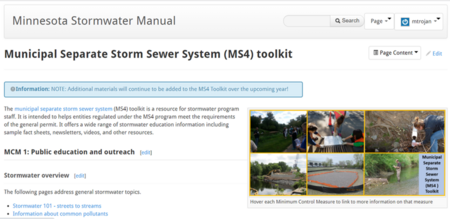
- Stormwater MS4 toolkit. The municipal separate storm sewer system (MS4) toolkit is a resource for local stormwater program staff. It is intended to help entities regulated under the MS4 program meet the requirements of the general permit. It offers a wide range of stormwater education information including sample fact sheets, newsletters, videos, and other resources. The toolkit was recently updated with information on stormwater management, including new videos. To see the new information, visit this page.
- Street sweeping: We continue to update information on street sweeping. Below is a summary of the latest updates.
- Recommended street sweeping practices for water quality purposes: This page includes a summary of recommended practices at the top of the page.
- Case studies for street sweeping: In December we conducted interviews with staff from seven cities that were implementing street sweeping for water quality purposes. The interviews illustrate how cities are modifying their sweeping efforts to enhance water quality objectives. Information from these interviews was used to develop the recommended practices mentioned in the previous bullet.
- Street Sweeping Phosphorus Credit Calculator How-to-Guide: This handy quick guide summarizes how to use the street sweeping calculator.
- What's next: We plan on meeting with several stakeholders to identify additional tools and resources they would like to help continue enhancing street sweeping for water quality. Following this meeting, we will determine what tools and resources we can produce. These will be incorporated into the Stormwater Manual as appropriate and further communicated through other means such as newsletters.
- We have developed total suspended solid (TSS) and total phosphorus (TP) credits for manufactured treatment devices. These credits represent the reduction in TSS or TP loading expressed as a percent for water treated by the device. There are additional needs for crediting mtds, including the following.
- Calculation of annual load reductions. The credits established for mtds only represent the percent reduction for water treated by a device. The volume of water treated by a device, typically expressed on an annual average basis, must be determined before calculating an annual pollutant reduction for the device.
- Credits for dissolved phosphorus (DP). TP credits are currently limited based on the assumption the devices are not removing dissolved phosphorus. The credit scheme includes three tiers. Tier 3 will include credits for removing DP. Before Tier 3 credits can be determined, however, we must develop methods for calculating the performance of a device with respect to DP. Ultimately, DP credits may be given for devices that have a mechanism for removing DP (e.g. an amendment) or that retain runoff water (e.g. through infiltration).
- Time frame: We anticipate completing guidance for calculating annual loads and for assigning Tier 3 credits by this summer.
What are we working on (February 2022)
- Iron enhanced sand filters. In 2019 we compiled a spreadsheet containing information on 164 iron-enhanced sand filters (IESFs) in Minnesota. At the time there was limited performance information for these bmps. We have executed a work order to revisit a subset of these bmps and analyze their performance. The resulting information will be used to update guidance on design, construction, operation, and maintenance of IESFs. Projected timeline - late summer 2022.
- Vegetation: We have created a new page in the wiki called Plant and vegetation information for stormwater management. This page provides a framework for information on plants and vegetation that will eventually be incorporated into the wiki. We have a current work order to develop information on site assessment, preparation, design considerations and recommendations for vegetation in stormwater management and on operation and maintenance considerations for vegetation in stormwater management. We anticipate this information will be available in late summer, 2022.
- Green infrastructure: A long-term project to improve information on Green Stormwater Infrastructure in the Manual started in 2021. This work will be completed in phases. A current work order addresses design considerations for green stormwater infrastructure best management practices. We anticipate this work being completed by late summer, 2022.
- Street sweeping: The MPCA is working with University of Minnesota Extension staff to identify tool and resource needs to promote street sweeping.
- Management and disposal of bioretention media. In spring, 2022, we anticipate having guidance on how to evaluate and manage bioretention media at the end of its life cycle.
Featured article - Managing chloride in stormwater runoff (February 2022)
It is widely acknowledged the most effective strategy for protecting receiving waters from chloride pollution is by reducing use of chloride-deicers. But elimination of deicers is not practical in the foreseeable future. Are there ways to manage urban runoff having elevated chloride concentrations?
A workgroup of stormwater and groundwater professionals recently produced a white paper, published by the Minnesota Groundwater Association, that addresses this topic. The paper, titled Impacts of Stormwater Infiltration on Chloride in Minnesota Groundwater, provides a discussion of chloride in stormwater runoff and potential groundwater impacts associated with infiltration of stormwater runoff.
Chloride concentrations in stormwater runoff are highly variable and seasonally dependent. Concentrations in winter range from several hundred mg/L to as high as 40,000 mg/L, with typical concentrations being closer to 1000 mg/L. Concentrations outside the deicing season are typically less than 50 mg/L, with concentrations decreasing from spring into fall. Chloride is toxic to aquatic life, with the aquatic life standard being 230 mg/L. The drinking water standard is based on taste and is 250 mg/L. Chloride is also toxic to vegetation, can corrode materials, and can inhibit lake mixing, which may in turn result in changes in phosphorus cycling.
Though chloride is not retained in soil, studies indicate it is attenuated in soil. As a result, there is a lag time between chloride entering soil, including a media-based stormwater best management practice, and its eventual movement to a receiving water, be that a lake, stream, river, or aquifer. Understanding this process and the eventual receiving water can help manage runoff containing chloride. The white paper provides the following conclusions.
- Where deicer use is not extensive, infiltration practices are protective of receiving surface waters. Infiltration may increase groundwater chloride concentrations, but not to concerning levels. In some cases, infiltration may offset other chloride sources (e.g. leaking infrastructure) and lead to water quality improvements.
- Where deicing is extensive, infiltration practices will likely lead to criteria exceedances in shallow groundwater. This chloride-enriched groundwater may migrate to local streams or drinking water aquifers.
- In baseflow-fed urban streams impaired by high winter chloride concentrations, infiltration practices may decrease instream winter concentrations through dilution. In-stream summer concentrations will be a function of concentrations in groundwater. If groundwater exceeds the aquatic life standard of 230 mg/L, baseflow-fed summer stream concentrations may exceed the standard.
The white paper also provides several recommendations for managing stormwater runoff that contains elevated concentrations of chloride.
- Develop a method to assess shallow groundwater vulnerability to chloride contamination, which include geologically-based aquifer vulnerability factors and deicing information, for which road density or percent imperviousness can be suitable surrogates.
- Use the aforementioned method to identify and map shallow groundwater vulnerable to chloride contamination.
- Encourage proper stormwater infiltration where appropriate.
- Infiltrate in areas not vulnerable to chloride contamination.
- In areas vulnerable to chloride contamination, distribute infiltration rather than focusing on a single location.
- Properly site infiltration practices with respect to receptors (e.g., lakes, streams, and shallow drinking water wells). For example, locate an infiltration practice within 4-8 months travel time from a baseflow influenced receiving stream to offset peak winter in-stream concentrations.
- Because permeable pavements require little or no deicing, encourage them for infiltration in suitable locations (e.g., walkways, driveways), particularly where deicing is common.
- Do not store snow in infiltration practices or in practices that will receive runoff from melting snow piles, unless the practice is offline (i.e. runoff does not enter the practice and instead bypasses it during snowmelt).
When snowmelt runs off from a surface or snow storage area, routing the meltwater across a permeable surface allows some infiltration and may slow the rate of delivery to the conveyance system. This may spread the delivery of chloride-rich water to receiving waters and smooth the peaks in chloride concentration in the receiving water.
In the news (June 2021)
- RESEARCHERS PROPOSE NEW DEFINITION FOR ‘GREEN INFRASTRUCTURE. You may have noticed we use the term Green Stormwater Infrastructure in this manual. This is because Green Infrastructure includes non-stormwater activities and practices and addresses topics such as human and ecological benefits. This article is provides a brief overview of a study What is green infrastructure? A study of definitions in US city planning, published in Frontiers in Ecology and the Environment (January, 2022). This study shows that even within the stormwater community, much of the focus is on hydrologic aspects of stormwater. Thus, for example, permeable pavement is often identified as an important green infrastructure practice, though it has limited benefits beyond water quality and volume reduction.
- Build Back Better. We've been hearing this for some time now, with little apparent progress toward final legislation. There is no shortage of articles and information on this proposed legislation and what it means for stormwater and water in general. This article provides a general overview of what was in the original proposal, indicating nearly 2 billion dollars were to be dedicated to rebuilding water infrastructure. Here are additional articles if interested in this topic: [1], [2], [3], and [4]. Will a bill get passed? If so, what will the implications be for stormwater?
- Urban Greening ‘Not A Panacea' For Dealing With Extreme Weather, Study Finds. The authors summarize a study (Cuthbert et al., 2022) point out that green stormwater infrastructure is just one piece of the urban hydrology puzzle. By itself, it cannot simultaneously solve issues of flooding and heat island mitigation.
- LOCALLY: The Doc is leaving the house. Mississippi Watershed Management Organization (MWMO) Executive Director Doug Snyder will retire at the end of February 2022, after nearly 20 years of service at the MWMO. We'll miss you Doug.
